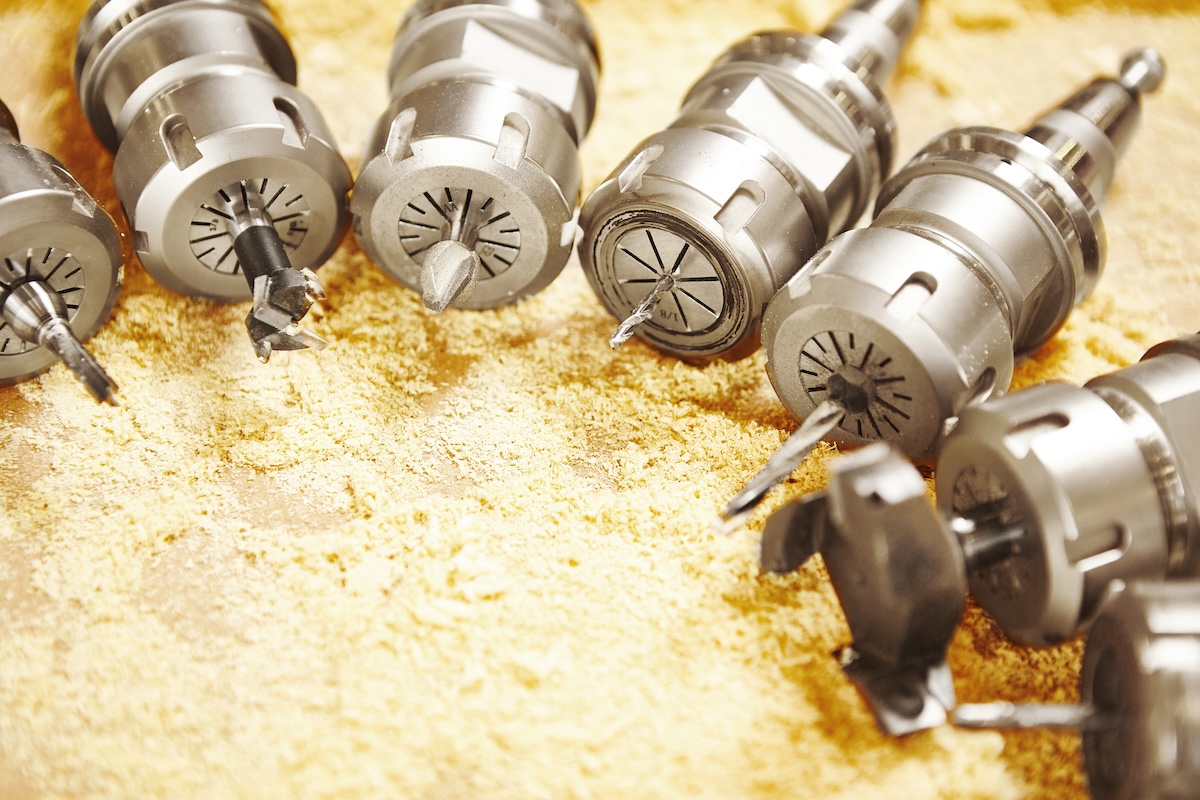

We may earn revenue from the products available on this page and participate in affiliate programs. Learn More ›
Handy homeowners and do-it-yourselfers who spend any time on improvement projects encounter situations where only a router can “cut it,” literally and figuratively. This carpentry power tool provides versatility that few other tools offer. It is the go-to tool for mortising door hardware, custom-engraving, joinery, and a whole host of other essential functions. To get the best use out of your router, you need a set of high-quality router bits.
Router bits are designed to serve three primary functions: to create wood joints, to plunge into the center of a piece for grooves or inlays, and to shape the edges of wood. While they’re hardly limited to a handful of cut-and-dried categories, the most commonly used router bits create grooves, joinery, or rounded-over edges. However, if you don’t know which router bit types serve which of these purposes, you could be leaving some of your tool’s potential on the table.
Want to elevate your woodworking projects? Discover some router bits you may not already have that can improve your game.
Grooving Bits
When you learn how to use a router, you typically start with one of the most useful and common router bits used for grooving, such as these two popular grooving bits.
1. Straight

Straight bits are perhaps the most frequently used type of router bit since they have a wide variety of applications. Straight bits are usually used for cutting different types of square-shaped grooves. These grooves can be cut with the wood grain (the technical definition of a “groove”), against the wood grain (called a “dado”), or along the edge of a piece of wood to produce an L-shaped shoulder, or “rabbet.”
All of these cuts are often used for joining two pieces of material. For example, the mortise and tenon joint is a very popular and sturdy joining technique that can be easily made with a straight bit. (A plunge router can also be used to make a mortise and tenon joint.)
Aside from joinery, straight bits can be used for mortising in door hardware, or for grooving a channel where a decorative inlay can be inserted. They can even be used in place of more specialized bits (such as a rabbeting bit, described below), contributing to their impressive versatility.
They’re available in cut diameters ranging from 3/16 inch to 1½ inches, and have either one or two “flutes” (cutting arms), depending on how large or fine a cut you need.
Best For: Making grooves, dados, mortises, and decorative inlays.
Our Recommendation: Freud Double Flute Straight Bit at Amazon for $15.24
Manufactured in Italy, the Freud straight bit is made with a precision-cut hook and shear angle that ensures straight, smooth cuts.
2. V-Groove

As the name implies, V-groove bits groove out a V-shaped profile in a piece of material, often to produce a decorative effect. V-groove bits can engrave designs in flat surfaces like signs or cabinet faces, create shallow grooves that run the length of a column (“fluting”), or even make ridges in panels to produce a beadboard effect. These bits come in a variety of diameters and V-groove angles that determine the width and depth of the groove. Some bits have flat bottoms instead of sharp tips to help limit the depth of the cut.
Best For: Making signs, fluted columns, and a beadboard appearance on panels.
Our Recommendation: Whiteside V-Groove Router Bit at Amazon for $17.12
The V-groove bit from Whiteside can make intricate engraving cuts at either a 90- or 60-degree angle.
Joinery Bits
Enthusiastic wood router novices can get more use out of their tools by adding a few joinery bits to their collections. These router bits are primarily used for cutting adjoining notches to give two pieces of material strong, durable joints. Each bit creates a joint in its own unique way.
3. Rabbeting
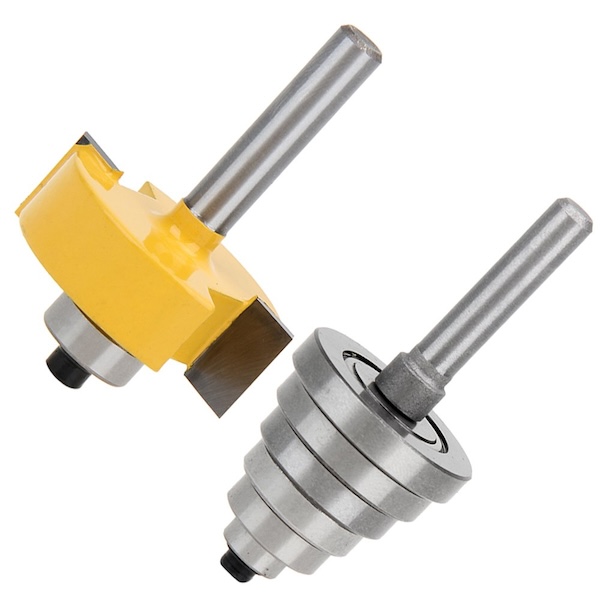
Rabbeting bits are designed to form an L-shaped shoulder or dado (square groove that runs against the grain) on the edge of a piece of material to form a rabbet joint. This type of wood joint is used in cabinetry construction to make drawers and cabinet backs, as well as to join the tops of cabinets to cabinet sides.
What distinguishes rabbeting bits from other bits, like straight bits, is the addition of a circular pilot bearing at the bit’s tip that acts like a spinning wheel riding along the edge of the piece being cut, guiding the cutting arm to the perfect depth. As a result, the width of the cut is determined by the size of the bearing, with a smaller bearing producing a wider cut. The most common sizes of rabbet bits are 1¼ inches and 1⅜ inches, and most bits come with several interchangeable bearings ranging from ⅜ inch to 1⅛ inches.
Best For: Creating rabbet joints to join two pieces of material.
Our Recommendation: Yakamoz Shank Rabbet Router Bit at Amazon for $15.99
The rabbeting set by Yakamoz offers a high-quality bit specifically designed to resist kickback and heat, along with six bearings of different sizes.
4. Glue Joint

Glue joint bits assist in joining two pieces of material by creating adjoining tongues on the edge of both pieces. The notched cuts provide plenty of surface area for gluing and form a tight-fitting joint that holds the pieces together while they’re being clamped. They’re available in two varieties: standard and mitered. The standard glue joint joins squared edges, while the mitered bit is made with a 45-degree angle to join two mitered edges.
Before you begin using these router bit types, know that they are meant to be used exclusively in a router table. Using glue joint bits in a handheld router can result in uneven profiles or, worse, injury if the router binds up and kicks back on you.
These bits come in sizes ranging from 1⅜ inches to 2¾ inches and can be used on material from ½ inch to 1¼ inches thick.
Best For: Creating two adjoining joints that have a higher surface area for gluing.
Our Recommendation: Yonico Reversible Glue Joint Router Bit at Amazon for $22.95
The Yonico reversible glue joint bit has a robust ½-inch shank and micro-grain composition, giving it superior cutting quality and longevity.
5. Flush Trim

Flush trim bits are essentially straight bits with a pilot bearing that’s the same diameter as the flutes. The bearing at the tip guides the cutting arm perfectly around the edge of a surface, allowing you to trim overhanging material perfectly flush. You can use these bits for shelf edging, veneer trimming, or for smoothly joining edges. They’re also great for duplicating curved patterns from a template. For trimming purposes, these bits can be used in a handheld router, but a table-mounted router is best when replicating patterns with a template.
Flush trim bits come in a variety of cutting arm lengths and diameters, but the most common are ½-inch diameter by a 1-inch length with a ¼-inch shank.
Best For: Trimming laminate and replicating patterns from a template.
Our Recommendation: Freud Bearing Flush Trim Router Bit at Amazon for $17.56
Freud’s ½-inch flush trim bit offers the larger ½-inch shank combined with Freud’s legendary quality to make the smoothest and most intricate of flush cuts.
6. Rail-and-Stile

Also called a cope-and-stick bit, a rail-and-stile router bit set is used to form a cabinet panel door’s interlocking corner joints. The pair of router bits is designed to work together, with the stile bit cutting the groove for the panel and the rail bit cutting the stub tenon (a short tenon that fits into the shallow groove). Using a pair that is manufactured together will create a nice fit.
There are a variety of rail-and-stile router bits. Each is designed to create a different type of profile joinery. Some popular types are Shaker, French Provincial, beveled, ogee, and beading. For those who want to limit the number of bits in their router arsenal, some tool makers offer a single bit that can cut both the rail and the stile.
Best For: Joining a cabinet door panel’s corner joints.
Our Recommendation: Whiteside Shaker Stile-and-Rail Set at Amazon for $116.61
The carbide-tipped set of two bits is designed to create shaker-style door panels on cabinets.
7. Slot Cutting
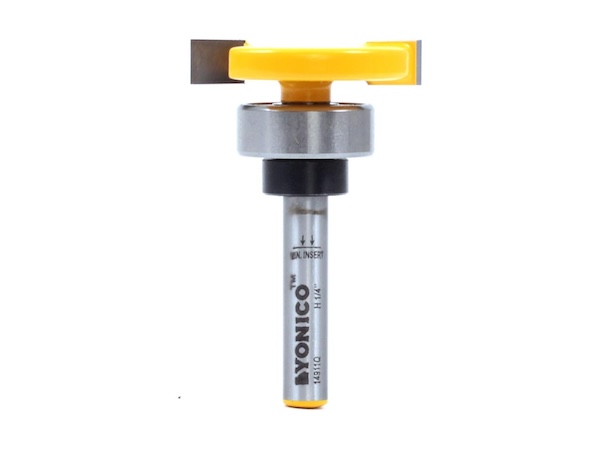
If you want to make a channel in a wood, create biscuit holes, or enhance a project with decorative features, a slot cutting router bit might be what you need. It creates a flat, straight cut through material and is often used in joining deck boards with a tongue-and-groove joint.
Some also use the bit for joining drawer bottoms, cutting slots to secure panels, and making decorative embellishments in woodworking projects. A slot cutting router bit may also be used to create rail-and-stile panels for cabinet doors and drawer fronts.
Best For: Creating slots to join deck boards or biscuit joinery.
Our Recommendation: Yonico Slot Cutter Router Bit at Amazon for $15.95
Made from tungsten carbide, the top-bearing slot cutting router bit creates a ¼-inch-by-¼-inch slot for joining wood.
Edge-Forming Bits
The next five router bit types are all designed for shaping the sharp edges of lumber in different ways and for different purposes.
8. Rounding-Over
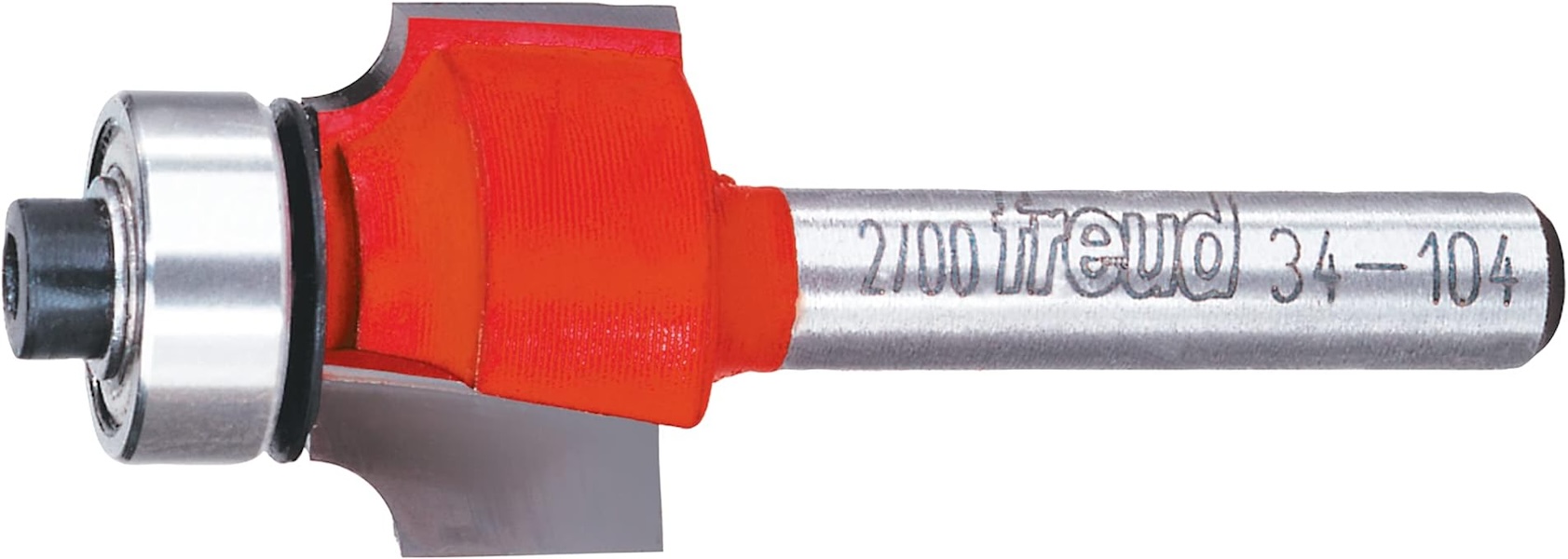
Not only are rounding-over bits the most commonly used type of edging bit, but they’re also perhaps second only to straight bits in how often they’re employed. They create a rounded profile to ease the sharp, 90-degree edge of a piece of wood, giving the material a smoother, finished look. The eased edge can also help preserve paint and stain, since these finishes are more prone to chipping off sharp edges. Rounded-over edges are also smoother to the touch and less likely to cause injury to those who come into contact with them.
These bits come in two forms: single and double. Single rounding-overs create their profile on a single edge, producing a quarter-round effect. The double rounding-overs bits cut the bottom and top edge simultaneously, making a full half-round profile.
Best For: Smoothing out sharp edges to preserve a project’s finish and creating a decorative edge.
Our Recommendation: Freud Radius Rounding-Over Bit at Amazon for $20.90
The ⅛-inch rounding-over bit from Freud is computer-balanced to reduce vibration and minimize kickback while producing an exceptionally smooth round-over cut.
9. Chamfer
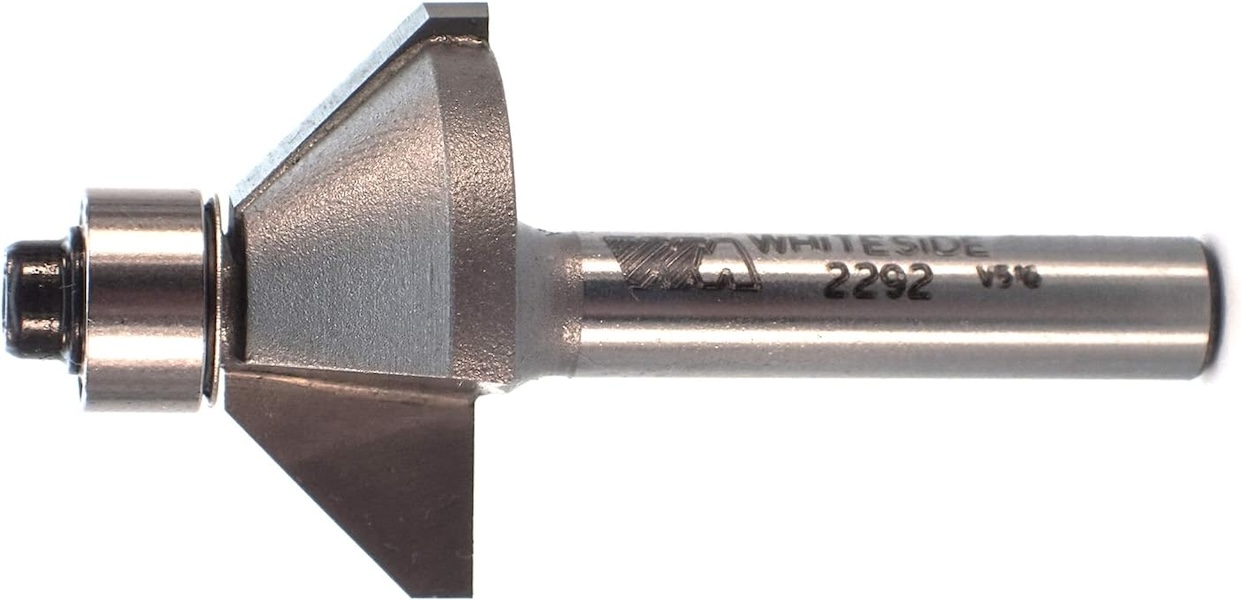
The chamfer bit is designed to produce a bevel cut on the edge of a piece of wood to serve either form or function—or both. The chamfer provides an attractive edge profile and a professionally finished look on any project with flat edges, including counters and tabletops. Its beveling ability can also make perfect miter cuts on long, bulky, or curved material. While ripping perfectly straight miters on long boards with a table saw and keeping them free from ugly saw marks or burns can be tricky, a chamfer bit in a router table can make exceptionally clean cuts. This is particularly useful when the angle of your miter needs to be spot-on, like when you’re making multisided boxes. And when you need to chamfer a curved edge, installing the bit onto a hand-held router allows the pilot bearing to smoothly track the curved shape—a feat no saw can perform.
Chamfer bits come in sizes ranging from ⅛ inch to 2½ inches in diameter with angles between 11.25 and 45 degrees. This wide range in size and angles makes these bits capable of creating miter joint angles from 22.5 to 90 degrees in material as thick as 1 inch.
Best For: Making decorative edges and joining two pieces of mitered material.
Our Recommendation: Whiteside Chamfer Router Bit at Amazon for $28.56
Whiteside’s 7/16-inch chamfer bit offers an affordable, high-quality option that is precision-ground to ensure proper balance under high RPMs.
10. Cove
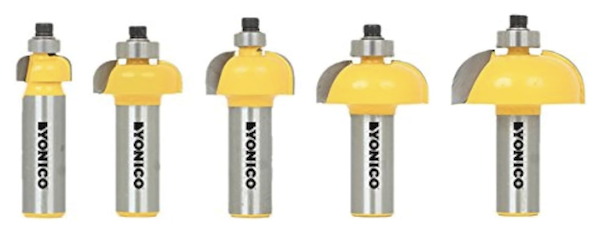
Cove bits produce a concave quarter-circle that’s essentially the inverse profile of the rounding-over shape. As opposed to the rounding-over, the quarter-circle of the cove is an indentation in, instead of an easing of, the edge of a piece of wood. It’s used for decorative purposes on the edges of window seats, stools, and tables, and can also be used to make moldings.
It can also be used with a complementary rounding-over bit to make adjoining edges for a rule joint—a type of folding joint used for drop-leaf tables. Cove bits are available in many sizes, most ranging from a radius of ⅛ inch to about 1 inch.
Best For: Creating a quarter-circle indentation in the edge of a piece of wood for decoration or joinery.
Our Recommendation: Yonico Cove Set at Amazon for $40.95
Yoniko’s five-piece cove set offers profiles from ⅛ inch to ½ inch, making it perfect for many types of projects and lumber dimensions.
11. Roman Ogee
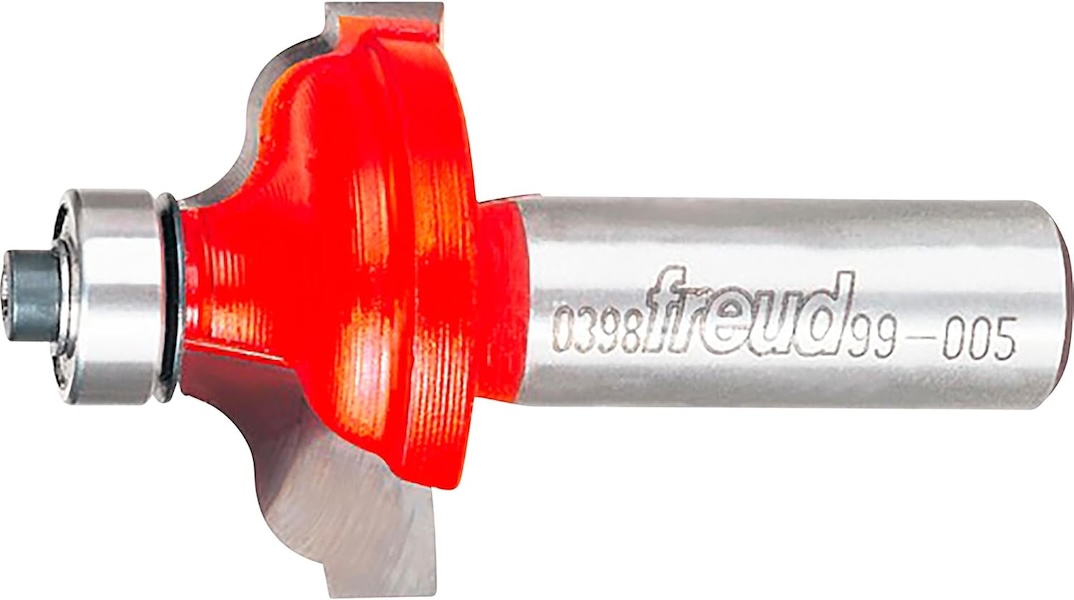
The Roman ogee bit creates a decorative S-shaped profile—in architecture, this shape is called an ogee—for molding, furniture, signs, or wherever a sinuous curve is desired. Ogee bits often incorporate straight edges at the top and bottom of the pattern with a convex curve in between.
Both classical and double ogee designs are available, with the latter containing two ogee patterns often separated by a squared transition. As with other edge forming bits, the tips are equipped with a pilot bearing to guide the cutting arms along the outside edge of the material. Bit diameters range from ½ inch to 2½ inches.
Best For: Making decorative S-shaped profiles in the edges of the material.
Our Recommendation: Freud Classical Roman Ogee Bit at Amazon for $36.80
This Classical Roman Ogee Bit has a nonstick coating and can be used with a ½-inch shank handheld or table-mounted router and creates a smooth decorative edge in plywood, composite, hardwood, and softwood.
12. Molding
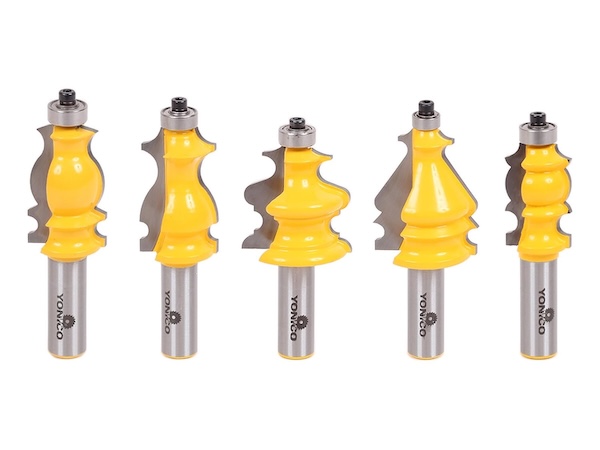
Molding bits integrate various edge-forming profiles to serve a single purpose: making molding. Molding is an incredible way to reinvent a room, and making your own moldings gives you the ultimate control over your home’s finishing touches. While several other types of router bits (like the cove and Roman ogee) are capable of making edge cuts for molding, molding bits save time and generate superior results.
With one of these bits in your possession, the sky’s the limit: You can manufacture crown molding, baseboard, and window casing all from a single set. There are several style options available, from classical to contemporary, to master any home remodeling project.
Best For: Manufacturing molding.
Our Recommendation: Yonico Molding Router Bit Set at Amazon for $80.95
This high-quality five-bit set from Yonico contains three case molding bits and two furniture base bits, making it highly versatile.
Specialty Bits
Some router bits are designed for creating specific effects, like making a bowl or freehanding designs on a sign. Here are a few particularly useful specialty bits.
13. Raised Panel
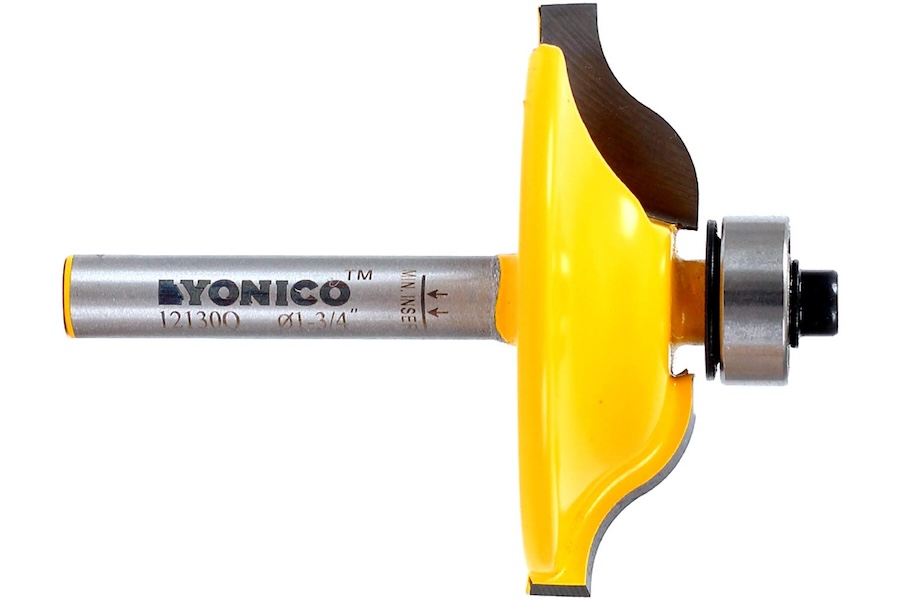
Because they are bigger than many other router bits, raised panel bits are typically used in a router table. They shape the edges of door panels or drawer fronts so they can slot into the frame’s rails and stiles. They’re available in horizontal and vertical versions; the vertical versions can be easier to use but are less versatile than the horizontal.
Depending on the intended profile, a woodworker may choose an ogee, cove, or Shaker raised panel router bit along with the corresponding stile-and-rail router bit set. The raised panel bit is also used on tabletops and moldings.
Best For: Shaping the edges of doors or drawer fronts.
Our Recommendation: Yonico Raised Panel Router Bit at Amazon for $19.95
This ogee raised panel router bit has a tough tungsten carbide blade and works with a table-mounted router.
14. Dish Carving

Sometimes called a bowl bit, the dish carving router bit is designed to remove a lot of material in order to hollow a block of wood to form the inside of a bowl or tray, raised-letter signs, insets on game tables, or any other kind of design that requires a large recess. What’s left behind is a smooth, curved surface. They’re available for handheld and table-mounted routers, and some dish carving bits can also work with plastic laminate.
Best For: Removing large amounts of material to create a rounded interior.
Our Recommendation: Freud Dish Carving Bit at Amazon for $23.52
Coated with its Perma-Shield Teflon-like coating, the Freud radius dish carving bit cuts a smooth recess in plywood, hardwood, and softwood.
15. Round Nose

A round nose bit is often used for making rounded grooves and edges on wood. Woodworkers choose the round nose bit when freehanding text on a sign or creating rounded decorative effects like fluting on a pillar or column. It can also be used to shape edges, create detail on cabinet fronts, and make channels in cutting boards and counters. Sometimes called core box router bits or bullnose bits, they can be used in CNC (computer numerical control) machines, router tables, or handheld routers.
Best For: Creating a rounded groove and freehand lettering on signs.
Our Recommendation: Whiteside Round Nose Bit at Amazon for $27.92
Made from premium carbide, the Whiteside round nose router bit can cut wood, composite wood, thin aluminum, and hard plastic.
Prices listed here are accurate as of April 23, 2025.
